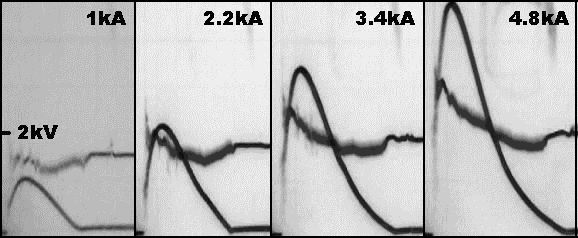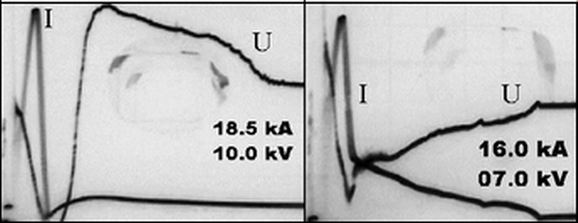
Commutation of lightning impuls by multiarc erosive radial-slotted discharge
Emelin S.E.
Scientific Research Institute of Radiophysics at the St.-Petersburg State University
Sergei.Emelin@pobox.spbu.ru
Abstract.
The non-stationary mode of radial-slotted erosive discharge was considered. The existence condition of the relatively steady multiarc regime has been found. Experimentally it has been shown that this discharge has been corresponding to the required condition at the sufficiently large current. The oscillograms of commutation of lightning impulse on the simulative test facility with the equivalent of a high-voltage transmission line are presented. The obtained results indicate the ability of erosive discharge, when using within the framework of the complex lightning protection facility, to fast commutation of lightning impulses at the level of rated current
1. Introduction. One of the most important aspects of the lightning effect on technical objects is connected to the capability of disturbance of its operating conditions or destruction of the high-voltage equipment [1]. Despite of considerable successes of lightning protection, the modern hardware don't guarantee the current-carrying parts of transmission lines against a defeat by the atmospheric discharges and if that's the case any drop of probability of ill effects depends to a great extent on the ability of a protective apparatus to counteract the overvoltages created by a large current of lightning impulses [2].
.The rated current of majority of modern excess-voltage suppressors is 5-10 kA by duration 30-50ms, that is many times less then most probable current of a first lightning impulse (30kA) [1-3]. Under the conditions of an actual lightning the remaining voltage is much more than the working voltage, that and it results in creation of a large voltage drop and of increase of energy accumulated in line inductance and absorbed by a protective apparatus [3]. Its reason is connected with the difficulties to provide for the greater nonlinearity of a voltage-current characteristic of non-linear resistors and varistors.
2. Lightning protection and electric discharge. Despite of seeming simplicity in design and capability to obtain a small value of remaining voltage under large current the correct application of an electric discharge as a sole base of any protective device is conjugated with the key difficulty to cut off own current directly after the decrease of a lightning current and the elimination of energy accumulated in the line inductance within this phase. This problem is resolved only partially by the spark dischargers, spark gap tubes and long-flashover arresters [4]. They create an electrical connection for rather long time to disconnect a power current at its zerolevel crossing or are levelled directly at an emergency switching-off.. The physical reason of the low switching off ability of the discharge gaps at a high-power level is the poor rate of the discharge energy drop for the maintenance of a high electric field strength of the arc.
3. Capabilities of erosive discharge. In the paper [5] the erosive radial-slotted discharge is described which has the heightened switching off ability and small time of its actuation, exceeding the typical duration of a lightning impulse. Due to the combination of circular configuration of a current and to the small altitude of a slot with the walls of easily evaporated dielectric, the specific mode of the working substance erosion is reached, that results in the increase of the electric field strength of a non-stationary arc at powers in tens megawatt and more. At external diameter of a slot 14cm, altitude of a slot 0.6mm and interelectrode distance on a surface of polymer 35 mm the discharger switches off the current at load 10 W at voltage 15 kV during period less 0.5ms. The cutoff of an inductive load current is accompanied by the final splash of voltage of a considerable value. The discharger is capable to pass many lightning impulses by duration 50ms with amplitude 5-10kA. The increasinge in altitude of the slot and the decreasinge in distance between the endings of electrodes allow to increase the maximum amplitude of a passed lightning impulse, but result in the drop of maximum voltage of switching off.
4. Problem situation. For adaptation of the radial-slotted discharge to high-voltage lines and to majority of actual lightning impulses (50-100kA) the research of the a possibility of creation of sufficiently steady multiarc regime achievable by a parallel connection of several dischargers was carried out. The solution of this problem for an open stationary arc in gas comes across the key limitations imposed by its falling voltage-current characteristic [6]. Therefore the multiarc regime is possible only in presence of ballast elements in the arms of a circuit. In discharges with a continuous gas supply the stationary splitting of a part of an arc column is possible within the rising interval of its voltage-current characteristic [7]. Our case differs by presence of individual arcs with magnetic coupling, conductive coupling between electrodes and also by a non-stationary mode. The cutoff the current of one arc or several arcs is nonreversible as a rule.
Being transient, the non-stationary discharge hasn't a defined voltage-curent characteristic. Because the voltage and the moment of switching off the current are depended upon its prehistory it is possible to speak only about the relative stability in some range of parameters, outside of which even large non-uniformity of current distribution is unessential for general outcome of transient, e.g. , at the end of the impulse, when the current magnitude is sufficiently small.
5. The chosen approach. The approximate answer to a question on stability of the multiarc regime is being determined at comparison of the voltage-current diagrams of one slot with different amplitudes of the impulse without account of intercoupling of individual arcs, in particular, of magnetic one. The precise answer is being determined only in experiment.

Fig. 1. Commutation of the lightning impulse by duration 50ms without the line equivalent
.On fig. 1 four oscillograms of the current of a lightning impulse by duration 50ms with amplitude 1kA, 2.2kA, 3.4kA, 4.8kA and of the voltage drop between the electrodes of the single-slotted discharger are presented. They show, that despite of change of resistance of discharge during the impulse the voltage magnitude is directly connected with the current magnitude for each moment after completion of the breakdown, excepting the final part of the impulse. The value of resistance in the maximum of the current changes from ~1.5W to ~ 0.5W. It signifies, that the uniform distribution of the breakdown on several slots should lead to the uniform distribution of a lightning current under the condition of equality of the slots parameters. At small currents the opposite effect is observed: at load resistance 0.5kW the discharge is not fired at the voltage 5kV and below.
6. Experimental check of the multiarc regime. Two dischargers with three and with eleven slots located with periods of slots 35 mm and 11mm accordingly that correspond to strong magnetic interaction of the arcs have been manufactured. External diameter is 14 cm and distance between endings of electrodes is 35 mm. For full elimination of a non-uniformity of distribution of a the breakdown the inductance was being included in each arm, and the full inductance of each discharger was ~3mH.
.The discharger was connected up to an equivalent of a transmission line with a lightning pulse former by an additional air gap. The high voltage line equivalent consisted of the capacitor Cline = 250 mF, charged up to 15kV, and the throttle Lline = 800 mH. For lightning impulse modelling the discharge of the capacitor Cpulse = 25 mF up to 20 kV through a current breaker with or without a noninductive powerful resistor 1.1 W was used. In the latter case the maximum amplitude of a lightning impuls by duration 50ms was 30 kA. Coming into operation, the breaker was disconnecting off the discharger from the lightning equivalent near zero voltage level on the capacitor Cpulse for elimination of its influence on the process of absorbtion by the discharger of energy accumulated in inductance of the line equivalent. The circuit breaker is necessary for correct simulation of lightning commutation by the test facility, as the discharger is switch of a current.

a b
Fig. 2.Commutation of the lightning impulse by duration 50ms in the multiarc mode with the line equivalent. a - Lline = 0.8 mH, Rline = 0; b - Lline = 0, Rline = 3 W;
In figures 2a and 2b the process of commutation by the 11-slotted discharger of the lightning impulse by amplitude 18.5 kA under voltage of the line Uline = 10 kV is presented; in the case of fig. 2b the inductance Lline is interchanged upon the wire resistor Rline = 3 W under Uline = 7 kV. They are an experimental affirming of the function ability of the multiarc regime in any lightning protection facilities.
7. Some features of the multiarc regime. The comparison of figures 2a and 2b is displaying also that the rising up of voltage, caused by extra currents of the line inductance, isn't containing the large single final splash, which, consequently, is a characteristic feature of the single-slotted discharger.
a . . ... b .. c
Fig. 3. Arc self-quenching. a 1 slot R = 11 W, L = 60 mH, U = 9 kV; b 1 slot R = 30 W, L = 0.8 mH, U = 7kV; c 3 slot R = 30/3 W, L = 0.8 mH, U = 9kV;
.For the explanation of this effect the process of the arc self-quenching into the 1-slotted discharger with load R = 10 W, L = 60 mH under U = 9 kV (fig. 3ΰ), with load R = 30 W L = 0.8 mH under U = 7 kV (fig. 3b) and into 3-slotted discharger with load 30 W sequentially with each slot and L = 0.8 mH in a common arm under U = 9 kV is presented. Comparing oscillograms, one can see the reason why the multislotted discharger creates considerably the smaller splash of the voltage in the presence of the inductive load, than the single-slotted: it is the immediate corollary of the magnetic interaction between arcs and of a non-simultaneous abruption of the currents in slots.
8. Energy of the commutation. Concerning the energy absorbed by protective apparatus directly during a lightning impulse and energy accumulated in an inductance, the discharger has apparent advantage in relation to the non-linear suppressor. The remaining voltage on the non-linear suppressor of the class 10 kV at so large currents is about 40 kV ( absorbed energy ~30 kJ), and the one on the discharger is 15 times less (absorbed energy ~2kJ). Considering that during a lightning impulse the discharger creates a mode close to a the short circuit, one can estimate the energy accumulated in Lline = 800 mH under Uline = 10 kV: Wline = 0.625 J. In the case of opposite polarity of a lightning and a line voltage the voltage drop on the inductance Lline will be about ~50 kV, and Wline = 15.6 kJ. Total energy is ~2.6 kJ for the discharger and ~46 kJ for the non-linear suppressor while allowable load of the one ~ 2 kJ/kV, i.e. 20 kJ.
9. Conclusion. The represented results demonstrate that the electric discharge is capable to provide deep suppression of overvoltage at the large overload on the level of a rated current, saving ability to the immediate switching-off the current of earth connection. The low value of remaining voltage should promote a decreasing of probability of steady short circuit at interphase flashover. We consider that these properties of the electric discharge create essential new ability within the framework of complex lightning protection facilities [9].
References